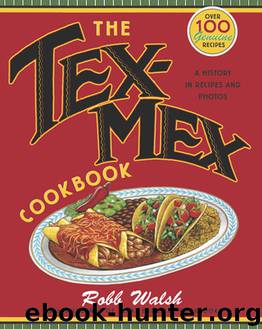The Tex-Mex Cookbook by Robb Walsh

Author:Robb Walsh [Walsh, Robb]
Language: eng
Format: epub
ISBN: 978-1-60774-770-3
Publisher: Potter/TenSpeed/Harmony
Published: 2014-08-19T04:00:00+00:00
Mexican pecan candies “MADE BY WHITE PEOPLE ONLY,” circa 1915
Obidia Rodriguez making pralines at Loma Linda Restaurant in Houston
Emma Tenayuca shakes her fist on behalf of striking pecan shellers on the steps of San Antonio City Hall.
THE SAN ANTONIO PECAN SHELLERS’ STRIKE
Thanks to cheap Mexican labor, a pecan-shelling industry developed in San Antonio. In the 1930s, half of the nation’s pecans passed through the four hundred pecan-shelling factories scattered around San Antonio. Although mechanized pecan crackers had already been invented, low wages during the Depression made it even cheaper to use Mexican laborers. After cracking the pecans (a job typically done by men because it requires great hand strength) came the meticulous chore of removing the meat from the cracked shells (a job usually done by women). Working conditions were poor, and the fine brown dust from the shells was a suspected cause of San Antonio’s high tuberculosis rate.
The shelled pecan market was eventually cornered by one man, San Antonio’s “Pecan King” Julius Seligmann. Labor representatives began to look into the low wages and poor working conditions at Seligmann’s plants. In 1934, Seligmann cut wages in half, stating, “The Mexican pecan shellers eat a good many pecans, and five cents a day is enough to support them in addition to what they eat while they work.” Meanwhile, Seligmann himself made more than half a million dollars over the following three years.
In response, the pecan shellers organized the International Pecan Shellers Union No. 172, part of the newly formed Congress of Industrial Organizations (CIO). On January 31, 1938, twelve thousand pecan shellers, almost all of them Hispanic women, walked off their jobs. During the three-month strike they called attention to the exploitation of Mexican laborers in Texas.
The strikers called on a well-known San Antonio labor organizer named Emma Tenayuca Brooks to lead them. Tenayuca Brooks was a member of the Worker’s Alliance, which was part of the Communist Party, and her husband, Homer, was a former Communist Party gubernatorial candidate. San Antonio politicians tried to stifle the strike, arresting hundreds of workers. San Antonio’s chief of police called the strike a Communist plot to take over the Mexican West Side.
Eventually the strike was settled, and the pecan shellers’ wages were raised. But then Congress passed the Fair Labor Standards Act of 1938 establishing a national minimum wage of twenty-five cents an hour. The CIO joined the pecan sheller’s union in asking Congress to allow an exemption, knowing that the higher wage would force the pecan industry to remechanize. But the Department of Labor rejected their pleas, and shelling machines soon replaced ten thousand workers.
Wages and working conditions for Mexican laborers remained substandard. But the San Antonio pecan shellers’ strike marked the beginning of a new era for Latinos. And the national attention it attracted helped pave the way for Latino labor and political movements that would follow.
Download
This site does not store any files on its server. We only index and link to content provided by other sites. Please contact the content providers to delete copyright contents if any and email us, we'll remove relevant links or contents immediately.
For the Love of Europe by Rick Steves(3202)
The Sprouting Book by Ann Wigmore(3052)
BraveTart by Stella Parks(2970)
Better Homes and Gardens New Cookbook by Better Homes & Gardens(2954)
The Death of the Heart by Elizabeth Bowen(2901)
Salt, Fat, Acid, Heat: Mastering the Elements of Good Cooking by Nosrat Samin(2658)
Sauces by James Peterson(2590)
Classic by Mary Berry(2501)
Solo Food by Janneke Vreugdenhil(2493)
The Bread Bible by Rose Levy Beranbaum(2472)
Ottolenghi - The Cookbook by Yotam Ottolenghi(2357)
Martha Stewart's Baking Handbook by Martha Stewart(2331)
Kitchen confidential by Anthony Bourdain(2306)
Betty Crocker's Good and Easy Cook Book by Betty Crocker(2280)
Day by Elie Wiesel(2241)
Hot Sauce Nation by Denver Nicks(2107)
My Pantry by Alice Waters(2040)
The Plant Paradox by Dr. Steven R. Gundry M.D(2038)
The Kitchen Counter Cooking School by Kathleen Flinn(2012)
